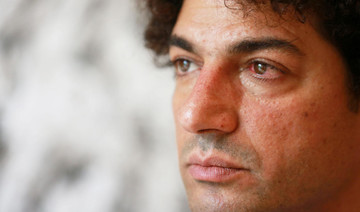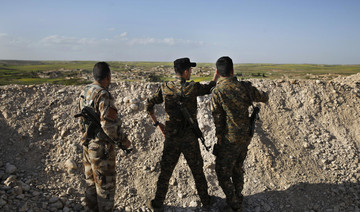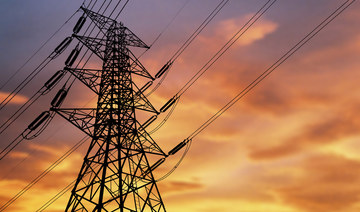LONDON: Two Iranian ethnic minority Kurds who allege they were tortured into making “confessions” are at imminent risk of execution, Amnesty International said Friday.
The human rights organization called on the Iranian authorities to immediately halt the planned executions of cousins Zaniar Moradi and Loghman Moradi who could be executed as early as Saturday.
The two men were held for nine months without access to their lawyers and families.
They say they “confessed” to murder after being tortured, including by being punched, kicked, and tied to a bed and flogged, as well as being threatened with rape. Their request for a judicial review of their case has been repeatedly ignored by the Iranian authorities.
“This is textbook Iranian ‘justice’. Two men are facing imminent execution after being sentenced to death on the basis of ‘confessions’ tainted by torture allegations. Despite the seriousness of the charges against them, their grossly unfair trial lasted just 20 minutes,” said Philip Luther, Amnesty International's Research and Advocacy Director for the Middle East and North Africa.
“We urge the Iranian authorities to immediately halt any plans to execute these men, to quash their convictions and sentences, and to order a new trial in proceedings that are in line with international fair trial standards. They must also investigate their torture claims and bring anyone found responsible to justice.”
The detainees have spent the last eight years on death row after being sentenced to death by public hanging in December 2010. They were moved from the general ward of Raja’i Shahr prison in the city of Karaj, north-west of Tehran, to solitary confinement cells in the same prison on 5 September 2018.
The prison authorities telephoned the two men’s families the next day and told them to go to the prison to visit their detained relatives, sparking fears that their executions were imminent.
Zaniar Moradi and Loghman Moradi have both repeatedly pleaded their innocence and denied the accusations against them.
They said that the Ministry of Intelligence targeted them in retaliation for the activities of Zaniar Moradi’s father, Eghbal Moradi, a well-known political dissident who was assassinated in July 2018.
Eghbal Moradi was a former member of the Komala Party of Kurdistan, a banned Iranian Kurdish opposition group based in the Kurdistan Region of Iraq, and a member of the Kurdistan Human Rights Association.
Zaniar Moradi and Loghman Moradi were arrested by Ministry of Intelligence officials on 1 August 2009 and 17 October 2009 respectively in the city of Marivan, Kurdistan province, and accused of the murder of the son of a senior cleric that had taken place in Marivan on 4 July 2009.
They said they were forced to “confess” to the murder in front of a video camera after being tortured. Their forced “confessions” were then broadcast on a programme that was aired on the state television channel Press TV in early November 2010, before their trial had even taken place.
In December 2010, after a trial that lasted just 20 minutes, Branch 15 of the Revolutionary Court in Tehran convicted them of “enmity against God” and murder. Their lawyer has told Amnesty International that the only evidence against them was their forced “confessions”.
Kurdish cousins at imminent risk of execution in Iran after convictions tainted by torture allegations
Kurdish cousins at imminent risk of execution in Iran after convictions tainted by torture allegations
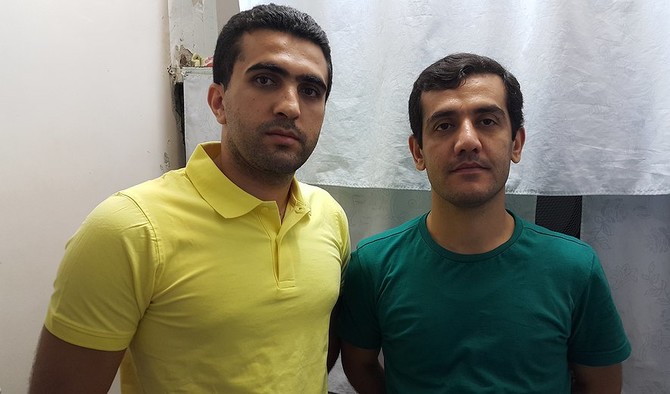
’Where can we go?’ say Rafah residents as Israel demands evacuation

- Areas designated for evacuation currently shelter some 250,000 people
- Israel’s retaliatory offensive, aimed at destroying Hamas, has killed at least 34,683 people in Gaza, mostly women and children
Israel’s army said it was instructing Palestinian families in eastern Rafah to flee in preparation for an expected ground assault on the city which abuts Gaza’s border with Egypt.
Residents of Rafah described emerging outside after a terrifying night in which around a dozen air strikes were carried out on Rafah, to find fliers falling from the sky telling them to “evacuate immediately.”
“The army is working with intensive power against the terrorist forces near you,” read a flier circulated in eastern Rafah.
“For your safety, the IDF (Israeli military) tells you to evacuate immediately toward the expanded humanitarian zone of Al-Mawasi,” it said, with a map indicating the location to the north of Rafah.
Osama Al-Kahlout, of the Palestinian Red Crescent Society in Gaza, told AFP that the areas designated for evacuation currently shelter some 250,000 people, many of whom have already been displaced from other areas in the Gaza Strip.
“The evacuation process has begun on the ground, but in a limited manner,” he said.
An Israeli militark spokesman, when asked how many people should move, said: “The estimate is around 100,000 people.”
About 1.2 million people are currently sheltering in Rafah, according to the World Health Organization, most having fled there during the seven-month war between Israel and Hamas Palestinian militants.
Amid pouring rain, some of those sheltering in Rafah said they had begun packing up their things from the densely packed tents and preparing to leave even before Israel’s directive arrived.
“Whatever happens, my tent is ready,” a resident told AFP.
But others said the area they were being told to flee to was already overcrowded, and they did not trust that it would be safe.
Abdul Rahman Abu Jazar, 36, said he and 12 family members were in the designated evacuation area.
Jazar and his family did not know what to do, he said, because the “humanitarian zone” they were told to head for “does not have enough room for us to make tents because they are (already) full of displaced people.”
“Where can we go? We do not know,” he told AFP.
“There are also no hospitals and it is far from any services many need,” he said, adding that one of his family members relied on dialysis at the Al-Najar hospital, in the area of Rafah instructed to evacuate.
“How will we deal with her after that? Should we watch her die without being able to do anything?“
An Israeli military spokesman told reporters that the evacuation “is part of our plans to dismantle Hamas ... we had a violent reminder of their presence and their operational abilities in Rafah yesterday.”
On Sunday, four Israeli soldiers were killed and others wounded, the army said, when a barrage of rockets was fired toward the Kerem Shalom border crossing between Israel and Gaza.
The army said the rockets were fired from an area adjacent to Rafah.
International aid organizations have voiced alarm at the expected invasion of Rafah.
“From the humanitarian perspective, no credible humanitarian plan for an attack on Rafah exists,” said Bushra Khalidi, advocacy director for Oxfam in the Palestinian territories.
She said she could “not fathom that Rafah will happen,” asking where displaced Palestinians will go “when most of their surroundings have been reduced to death and rubble?“
Gaza’s bloodiest-ever war broke out following Hamas’s unprecedented October 7 attack on Israel which resulted in the deaths of more than 1,170 people, mostly civilians, according to an AFP tally of Israeli official figures.
Militants also seized some 250 hostages, with Israel estimating that 128 of them remain in Gaza, including 35 whom the military says are dead.
Israel’s retaliatory offensive, aimed at destroying Hamas, has killed at least 34,683 people in Gaza, mostly women and children, according to the Hamas-run territory’s health ministry.
SEC closes $3bn financing for 3.6GW capacity power stations
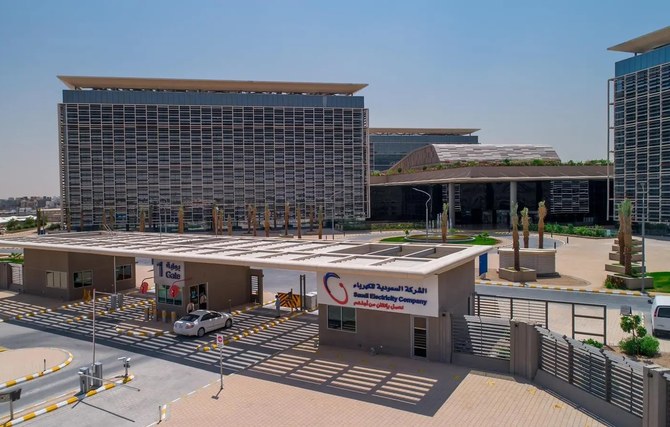
RIYADH: Saudi Arabia’s power generation is poised for a substantial boost following the successful closing of financing for two electricity projects, with a combined capacity of 3.6 gigawatts.
The deals involving the Taiba 1 and Qassim 1 independent power producer projects, with a combined financing value of SR11.4 billion ($3.04 billion), signify a major milestone in Saudi Arabia’s energy landscape, the Saudi Press Agency reported.
The two IPP projects, featuring combined cycle gas turbine technology, were awarded to the Saudi Electricity Co. by the Saudi Power Procurement Co. as part of an alliance with ACWA Power in October 2023.
Additionally, in November 2023, a 25-year power purchase agreement was signed with the SPPC for both projects, which are being developed on a build-own-operate basis.
Khalid Al-Qunun, CEO of SEC, commended the efforts of the company’s team in driving transformation in the electric energy sector in the Kingdom, the SPA report added.
He said: “These projects embody our ongoing ambitions to expand energy generation projects and adopt the latest technologies to ensure the provision of environmentally friendly energy solutions that contribute to achieving the company’s zero neutrality target by 2050, in line with the Kingdom’s ambitious aspirations in the field of energy sustainability.”
The financing agreements were signed by the two project companies: Sidra One for Electricity for the Taiba 1 station and Qudra Energy for the Qassim 1 station. The SEC holds a 40 percent share in both companies.
These modern stations represent a notable advancement in electric energy production in the Kingdom. They signify an important step toward a sustainable future by utilizing the latest energy production technologies, such as combined cycle gas turbines known for their high efficiency.
According to the SPA report, relying on these advanced technologies contributes to improving generation efficiency, reducing emissions, and reducing reliance on liquid fuels in the electricity production sector in the Kingdom.
These stations mark the beginning of a series of CCGT stations that will expedite the realization of Saudi Vision 2030 goals, including achieving an optimal energy mix and increasing local content.
This also sets the stage for achieving the goals of the Saudi Green Initiative, aiming for carbon neutrality by 2060. The engineering design of these stations allows for the future integration of carbon capture facilities, underscoring the SEC’s commitment to environmental, social, and governance responsibility, the SPA report added.
US weapon system identified in Israeli-Lebanon strike may breach international law

- Guardian investigation with Human Rights Watch identifies Boeing-made Joint Direction Attack Munition fragments at site where aid workers were killed
- US bans export of such systems to foreign militaries where ‘credible information’ of human rights breaches exists
LONDON: An Israeli airstrike in Lebanon that killed seven aid workers in March may have been conducted with a US-supplied weapon system, according to an investigation by The Guardian.
The incident claimed the lives of seven paramedics aged 18-25, all volunteers, at an ambulance center in Al-Habariyeh in southern Lebanon on March 27.
It came five days before an Israeli strike in Gaza killed seven aid workers working for World Central Kitchen.
Debris found at the scene in Al-Habariyeh was identified by The Guardian, an independent expert and Human Rights Watch as having belonged to a 500-pound Israeli MPR bomb and a Boeing-made Joint Direction Attack Munition, a system attached to explosives to turn them from “dumb bombs” into GPS-guided weapons.
HRW’s Lebanon researcher Ramzi Kaiss told The Guardian: “Israel’s assurances that it is using US weapons lawfully are not credible. As Israel’s conduct in Gaza and Lebanon continues to violate international law, the Biden administration should immediately suspend arms sales to Israel.”
The US government is legally unable to help or arm foreign militaries where “credible information” of human rights abuses exists, under the terms of the 1997 Leahy law.
A spokesperson for the US National Security Council told The Guardian: “The US is constantly working to ensure defense articles provided by the US are being used consistent with applicable domestic and international law. If findings show violations, we take action.”
But Josh Paul, a non-resident fellow with Democracy for the Arab World Now and a former State Department employee, said: “The State Department has approved several of these (weapons) transfers on a 48-hour turnaround. There is no policy concern on any munitions to Israel other than white phosphorus and cluster bombs.”
He added that JDAMs have been “key items” regularly requested by Israel since the start of the Gaza war.
Secretary of State Antony Blinken will deliver a report on Wednesday to Congress on Israel’s use of American weapons and whether they may have been involved in violations of this or other laws.
Maryland Sen. Chris Van Hollen told The Guardian that the findings from Al-Habariyeh are “deeply concerning and must be fully investigated by the Biden administration, and their findings should certainly be included in the NSM-20 report that is due to be submitted to the Congress on May 8.”
The airstrike on the ambulance center in Al-Habariyeh came without warning before 1 a.m. on March 27. No fighting had been reported in the area.
The victims had been at the center for the night shift, and were named as twin brothers Hussein and Ahmad Al-Shaar, aged 18; Abdulrahman Al-Shaar, 19; Mohammad Hamoud, 21; Mohammad Al-Farouk Aatwi, 23; Abdullah Aatwi, 24; and Baraa Abu Kaiss, 24.
The Israeli military claimed that the strike, which leveled the two-storey building, killed a “prominent terrorist belonging to Jamaa Islamiya,” an armed Lebanese political group with ties to Hezbollah. It did not identify the person by name.
A Jamaa Islamiya spokesman acknowledged that some of the ambulance volunteers were members of the group, but denied that they were part of its armed wing.
Samer Hardan, head of the local Civil Defense center who was among the first responders, told The Guardian: “We examined every centimetre looking for parts of bodies and their possessions. We saw nothing military-related. We knew (the victims) personally, so we could identify their remains.”
Since Oct. 7, 16 medical workers have been killed by Israeli airstrikes in Lebanon, and a further 380 people have died including 72 civilians. Eleven Israeli soldiers and eight civilians have also been killed.
Kassem Al-Shaar, father of Ahmad and Hussein, said he had warned his sons not to volunteer.
“I told them that it was dangerous to do this type of work, but they said that they accepted the risk. I don’t know what Israel was thinking — these were young people excited to help others,” he said.
“My sons wanted to do humanitarian work, and look what happened to them. Israel wouldn’t dare to do what they did if it wasn’t for the US standing behind them.”
Qatar’s non-energy private sector records improvement in April

RIYADH: Qatar’s non-energy private sector witnesses improvement in business conditions in April as the Purchasing Managers’ Index hit 52, compared to 50.6 in March, according to the latest data.
The Qatar Financial Center PMI is a composite single-figure indicator of non-energy private sector performance that is derived from indicators for new orders, output, employment, suppliers’ delivery times and stocks of purchases. A reading above 50 signifies sectoral expansion, while below that mark indicates contraction.
The latest PMI survey data from the center compiled by US-based capital marker firm S&P Global showed that the 1.4-point increase between March and April in the headline figure was among the largest registered over the past two years, according to a statement.
Moreover, the data disclosed that while output, new orders, employment and purchasing activity all increased at faster rates than in March, price pressures turned slightly negative, as both input and output prices fell marginally.
Additionally, the volume of incoming new business in Qatar’s non-energy economy rose at the fastest rate in seven months in April. This is mainly attributed to new customers and high quality, competitive products.
Total activity also surged at the fastest rate since last September in April as new projects and firms continued to complete existing workloads.
Furthermore, non-energy private sector companies were increasingly optimistic on growth over the next 12 months in April. Companies residing in the Gulf country linked positive forecasts to marketing campaigns, business development plans and efficiency drives.
Consequently, stronger inflows of new work and increased confidence led to a sharper rate of hiring growth in April. Employment has risen for 14 months, and the rate of job creation was running above the long-run survey average in April.
The Qatar PMI indices are compiled from survey responses from a panel of around 450 private sector companies. The panel covers the manufacturing, construction, and wholesale as well as retail and services sectors, and reflects the structure of the non-energy economy according to official national accounts data.
Islamic banking
The total value of the assets of Islamic banks operating in Qatar during the month of March 2024 increased by 6.4 percent on an annual basis to reach about 563.9 billion Qatari riyals ($154.8 billion), according to newly released statistics.
The monetary bulletin issued by the Qatar Central Bank for the month of March showed that this recorded figure represents 28 percent of the total assets of banks in Qatar, amounting to approximately 1.99 trillion riyals.
The data also revealed that the total value of Islamic banks’ financing in Qatar increased to 389.9 billion riyals, an increase of 3 percent over the corresponding month of last year.
Hareed Festival: A window into the heart of the Farasan Islands

- Annual event highlights tourism potential
Riyadh: The Farasan Islands, a string of coral islands nestled 40 km off the coast of Jazan in the Red Sea, have been abuzz with activity recently as they hosted the 20th Hareed Festival.
This vibrant annual event celebrates the arrival of parrotfish, also called hareed, in the islands’ shallow waters, the Saudi Press Agency reported on Sunday.
The islanders have cherished this event for generations, transforming it into a social gathering that goes well beyond the arrival of the fish.

Visitors to the festival got a glimpse of the islands’ rich cultural heritage as it showcased the area’s unique customs, traditions, folk games, and handicrafts. It also focused its spotlight on Farasan’s remarkable tourism potential and historic sites.
Al-Dana provides one of the highlights. It is a captivating form of vocal art that is one of Farasan’s oldest folk traditions. It forms a poignant expression of longing, a result of the hardships endured by sailors on extended pearl-diving expeditions. The challenges faced by these brave men fueled the art form, which is deeply rooted in Farasan’s cultural identity.
The annual festival also gives an opportunity for Farasan residents to display their traditional handicrafts. Visitors can watch the making of fishing traps and nets, the intricate weaving of palm fronds, the creation of bags and rugs, and hat knitting.
A designated area at the hareed fishing site catered to families and children. Visitors could experience the thrill of catching parrotfish using a traditional method that involved setting up barriers to prevent the fish from escaping. This competition, a centuries-old tradition, allowed families to connect with the region’s fishing heritage.

Farasan’s most renowned tourist attractions highlighted the islands’ potential for tourism.
Al-Qassar village, which is located only 5 km from Farasan Grand Island, is a popular tourist site. This heritage village, which is built of stone and palm leaves, is home to the archipelago’s largest palm oasis.
Al-Qassar has served as a summer retreat for Farasan residents. People travel by camel to spend a three-month break in the village during the season of Al-Asef, the northwestern summer wind that comes after the hareed fishing season.
Famous for its abundance of fresh groundwater, Al-Qassar village comprises around 400 houses. These unique dwellings, with stone walls and roofs made of palm tree planks, leaves, doum palm, or anisotes trisulcus branches, topped with algae and mud, are made by traditional building techniques designed to withstand the elements.
The Hareed Festival is a window into the heart and soul of the inhabitants of the Farasan Islands; a celebration of culture, tradition, and the islands’ natural beauty.


